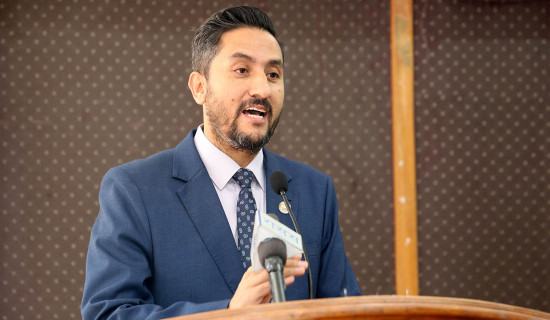- Wednesday, 17 December 2025
Ensure Quality Of Medical Education
The Medical Education Commission (MEC), which has been established as per the National Medical Education Act, 2075, is mandated to manage the medical education sector in an effective manner. As a regulatory body, MEC came into being at a time when the country’s medical education was in a mess. The nation witnessed a mushrooming growth in the number of medical colleges that did not have even basic physical infrastructure and human resources. Despite being a very sensitive sector, medical education was commercialised in such a way that there were massive manipulations in terms of granting universities’ affiliation to colleges, allocation of seats for the undergraduate level and enrolment of students. This sector was in the grip of unhealthy business practices. There were many public grievances against private medical colleges as they were found overcharging students under different headings. But the quality of education provided by those institutions was deteriorating. So, this sector was reeling from massive irregularities.
Even the colleges affiliated to the Institute of Medicine (IoM) were not free from problems. There was a tendency among colleges to show competent faculties only in documents. Such colleges also lacked other infrastructures essential for imparting quality education. Before the establishment of MEC, the B. P. Koirala Institute of Health Sciences (BPKIHS) and Kathmandu University (KU) were also allowed to conduct separate entrance exams. With no proper regulation and monitoring due to vested interests, chances were high for all the responsible institutions of evading meritocracy while enrolling students. Making money seemed to have been the motto of the institutions, especially the affiliated ones, as they used to prioritise students who could afford to pay as much money as they demanded.
Protest
It is quite apparent that a series of protests staged by Dr. Govind KC led to the creation of MEC. The issues raised by Dr. KC were genuine as he wanted the country’s medical education system reformed significantly. No doubt, the inception of MEC can be taken as an important milestone in the history of our medical education. It must be acknowledged that the Commission has already begun showing several desired results. It is vital that an integrated entrance exam system is now in practice. Students interested in pursuing various medical disciplines like nursing, pharmacy, medicine and dentistry are required to participate at national-level entrance examination before getting enrolled in different colleges. With this system, a sense of transparency has been maintained. It has also brought uniformity in all the institutions. Students are enrolled in colleges through respective universities. Now students also need to pay fees to colleges through universities. This practice is expected to prevent colleges from cheating students monetarily on one pretext or the other.
However, there are still many seen and unseen obstacles. For MBBS course, colleges are allowed to charge up to Rs. 4.5 million as tuition fee from each of students. But due to inflations, per student medical education cost has now increased to Rs. 5.5 million. Because of this, colleges are often found raising extra amount of money from students under various titles to cover their growing costs. Since the existing fee ceiling of Rs. 4.5 million is not practicable in the present context, it needs to be revised logically. MEC’s existing structure is not capable of carrying out its responsibilities efficiently. So, it has to rely on its hired inspectors who may not always maintain their integrity while performing their duties.
Another unfortunate trend is that the performance of students in the entrance exams is assessed on the basis of percentile system. In the past, students had to secure at least 50 per cent marks to be eligible for getting enrolled in any undergraduate course and for getting eligibility certificate to study abroad. But it seems that under the influence of certain groups having selfish interests, MEC has gone for such a low percentile. There is no doubt that this system is a universally accepted one. But the MEC management should have increased the cutoff point of percentile so as to choose only worthy students. Under the percentile system, even students acquiring 20-25 per cent marks (falling within 50th percentile) can get eligibility certificate and can get enrolled in colleges abroad.
When such students become doctors from substandard institutions abroad and somehow get through the only knowledge-based licensing examination conducted by the Nepal Medical Council, the nation’s healthcare service is sure to suffer a setback so MEC must rectify this decision at the earliest to enhance the quality of medical education. There are many loopholes in laws pertaining to medical education. Issues related to the autonomy of universities to monitor the colleges, recommending the annual seats for admission are put on the back seat. If sensible measures are not taken on time, our medical education is sure to be in the doldrums as it is already at high risk of collapse in terms of quality. Possibility of autocratic MEC in the future cannot also be totally ruled out. We must work towards developing competent and highly skilled manpower in order to improve the nation’s healthcare services.
Way forward
It is necessary to develop MEC into an autonomous body so as to handle the entire medical education sector successfully as well as to make certain required amendments to the MEC Act to respect the autonomy of universities. Much focus should be laid on further consolidating meritocracy by remodeling the examination system. An aptitude test also needs to be part of the examination. As mentioned above, a cutoff point of the percentile system should be fixed through ensuring that there is no any compromise on quality as per the requirement of the discipline. To boost the quality of education imparted by colleges, global innovations should be included in curricula. The traditional way of teaching-learning process should be replaced with modern one. A competency test should be incorporated in the evaluation system to make it relevant.
Nepal holds a lot of prospects for medical education development. For this, our universities and colleges should be competitive when it comes to imparting quality education. A number of Nepali students go abroad for higher education in a variety of disciplines annually. Countries like the USA and Australia have adopted the policy of attracting international students to support their economy. Nepal, too, can do this. But what we need is internationally accredited colleges with sound academic and transparent system.
(An eminent neurologist, Dr. Agrawal is a member of the Medical Education Commission and former Dean of the IoM.jpdagrawal@gmail.com)
















